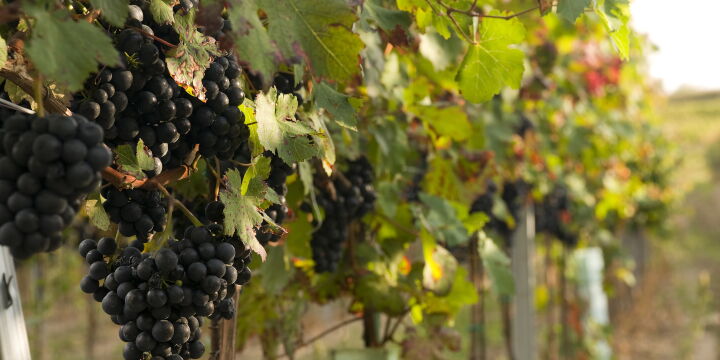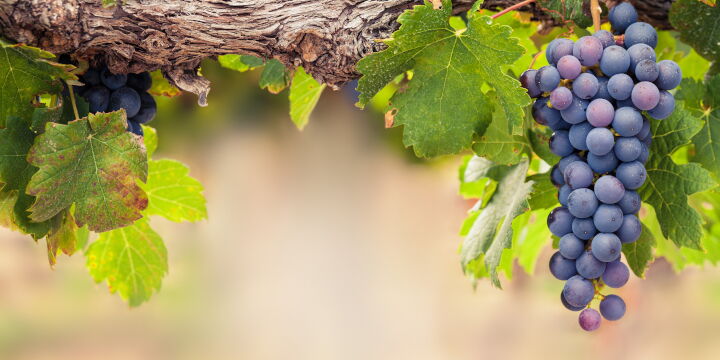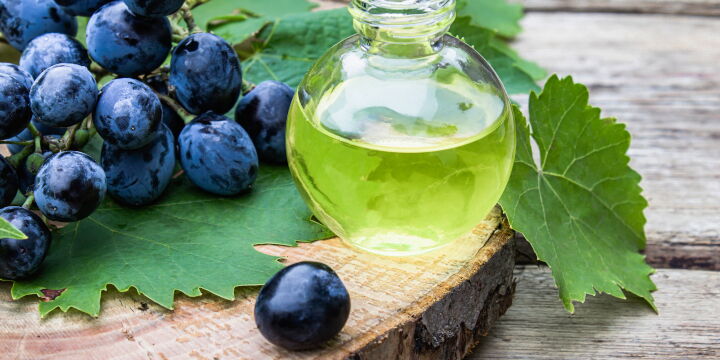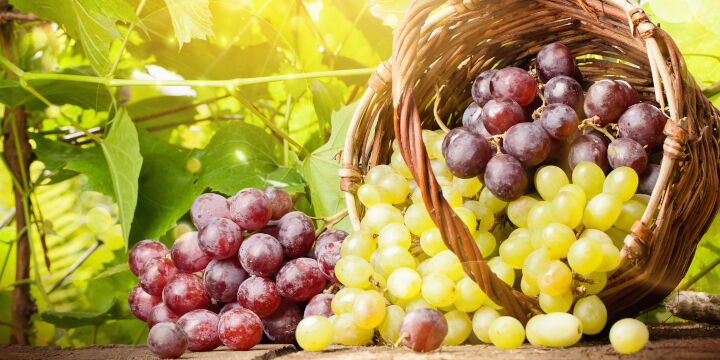Already known by the Greek people, the grape is a concentrate of vitamins and nutrients: good, rich, distinct in its variants, it is a fruit much appreciated and consumed in the world and not only for the production of wine..
The origins of the grape have distant roots and, historically, the cultivation of this fruit developed in 7500 BC. It was the Greeks who introduced the grape harvest and the rite of the grape harvest with the cult of Bacchus, the inventor of wine, in Hellenic culture. The vine also arrived in Italy, where the Etruscans, in particular, began to devote themselves to its cultivation, marking the beginning of a cult that will accompany our country for centuries to come.

Italy is today one of the world's largest grape producers with Lazio holding the record for quality and quantity produced
Used as a table fruit and in the production of wine; it is one of the most popular ingredients also in the production of cosmetics and food supplements due to the high amount of beneficial substances it contains.
The variants, including those characterizing its taste, vary according to the area of provence and the climatic conditions to which it is exposed and are all characteristics capable of varying even the concentrations of sugar and properties contained within it.

Its one of the most sugary fruits of all but despite the high glycemic index it remains one of the fruits with many beneficial properties
Despite these data, its caloric intake is relatively low (60Kcal per 100g) of which 3% is represented by proteins (in particular essential amino acids) and 1% by fats.
Rich in water and fiber; essential to minimize constipation, grapes also have minerals such as potassium, calcium and phosphorus but also iron, zinc and manganese which are useful for the formation of hemoglobin, favoring the digestive and diuretic process and for the secretion of bile.
Rich in flavonoids, its pulp is known for the presence of a high percentage of vitamins of group B (B1and B2 in particular) but also of A and C.
Its skin is a concentrate of polyphenols, also indicated with the term Vitamin P; a group of substances with a high antioxidant and anti-inflammatory power against degenerative and inflammatory diseases.
Among these we find resveratrol an anti-inflammatory with antioxidant action, useful against cholesterol and in the prevention of cardiovascular diseases.
Resveratrol counteracts the memory drops, learning difficulties and mood drops typical of advancing age.

Thanks to the presence of polyphenols and vitamins, the skin also benefits from this fruit which stimulates the production of collagen.
The grape seeds, the seeds contained in the grape, find application in cosmetics and dressing thanks to their emollient and lubricating properties.
The tannic acid content is able to counteract herpes simplex: applying grape must or juice on the lips accelerates healing times while applying the grape puree on the face has revitalizing and astringent effects.
Grapeseed oil, rich in polyunsaturated fatty acids, is an ingredient very often used in the formulations of food supplements as it is useful in the management of cholesterol and for the protection of blood vessels.

Grapes on the tables have always represented a symbol of wealth, and still today at the end of the year they are an auspicious symbol of health, well-being and prosperity..
Ampelotherapy: the treatment that rejuvenates
From the Greek ámpelos, vine; it is the grape cure that consists in consuming this fruit when it has reached a good degree of maturity and as the only daily food.
To obtain evident results from this treatment, the grapes must be consumed directly on the place of collection to avoid being manipulated and in daily doses between 500g and 2Kg per day.
During the grape treatment, which can only be followed for a few days and under medical supervision, it is recommended to drink water and herbal teas and then the grapes will take care of the rest.
Its indicated to rejuvenate the body and is useful in case of arthritis, retention, constipation and disorders of the management system.
If consumed excessively, grapes can create unpleasant situations. Furthermore, it is a food not suitable for those suffering from gastric ulcer or similar pathologies: the presence of fibers leads to fermentation processes.

Fresh, white or strawberry, grapes are a versatile fruit in the kitchen to be used in various sweet and savory recipes. Its being sweet but also acidulous makes it perfect with cheeses.
Try my soft lemon plum cake with white grapes..

Simple, healthy and with very few ingredients; a versatile dough that can be enriched with dried fruit or chocolate chips. I recommend trying a few slices with walnut cream..
INGREDIENTS
160g of spelled flour
15g of honey (or rice syrup)
1 large egg (65g)
50g of organic coconut oil
125g of milk
8g of yeast
Zest of 2 lemons
White grapes 15-20 berries
METHOD
Clean the grapes: remove the grapes from the stalk and cut them in half, removing the seeds.
We pour over some lemon juice and set aside.
We turn on the oven at 180° (static)
In a container, work the egg with the honey for a few minutes with the electric whisk positioned at maximum speed, obtaining a light and fluffy mixture.
Flush, always with the whips moving, we also combine the oil, milk and lemon zest.
Let's add the sifted flour with baking powder.
Get a creamy and lump-free mixture.
Also combine half of the berries leaving some for the surface.
We pass the coconut oil in a loaf pan and pour the cream.
Decorate with the remaining grapes and cook for 25 minutes.
Let it cool completely and enjoy.
I recommend trying this dessert by serving it with Walnut Cream for an explosion of flavors not to be missed!
Nutrition, Protective effects of a grape
Manfred Urs Koch, Enciclopedia degli alimenti per la salute e il benessere
